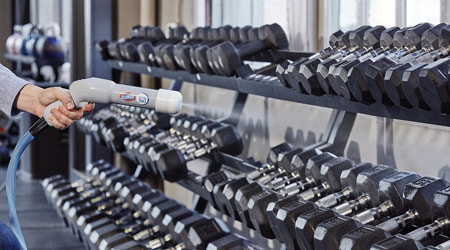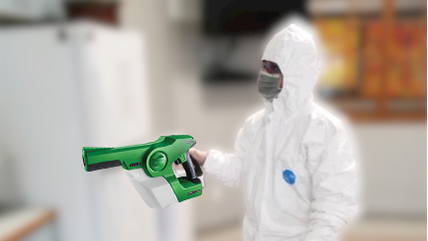 Disinfection vs. Cleaning - What's the Difference? Due to the pandemic and businesses now preparing to re-open, we are getting a lot of calls asking for a “deep clean”. Yet, when we ask them questions to determine what they are really looking for, we are discovering what they are really seeking is disinfection. This also prompts a discussion of the differences between cleaning and disinfection. It is important to know the difference, ask the right questions, and know what service you're getting. What is Deep Cleaning? Deep cleaning is generally just a surface clean, or what some people refer to as a good, “spring cleaning”. For instance, cleaning cabinets (inside and out), deep scrubbing of certain areas or surfaces, cleaning out and washing refrigerators, etc. However, this does not mean a cleaning of undersides of tables and high traffic items like light switches, door knobs, or chair arms. It is these places, that we touch often in our homes and businesses, where germs and viruses can linger. If you are looking to eliminate viruses, as well as other germs and bacteria, you need more than just a deep cleaning. Sanitization, Disinfection or Sterilization? The terms sanitization, disinfection, and sterilization sound similar, but they are very different. Sanitization reduces overall pathogenic microbes on surfaces. While disinfection requires the disinfectant to remain on a surface for a period of time in order to be effective. According to the CDC, “Cleaning refers to the removal of dirt and impurities, including germs, from surfaces. Cleaning alone does not kill germs. But by removing the germs, it decreases their number and therefore any risk of spreading infection.” Source: CDC.gov Whereas, disinfecting works by using chemicals, for example EPA-registered disinfectants and/or hospital-grade products, to kill germs on surfaces. This process does not necessarily clean dirty surfaces or remove germs. But by disinfecting, you can kill germs that remain on a surface after cleaning to further reduce any risk of spreading infection. This is why it is important to ask the right questions and understand what service you will be provided. At Millennium Cleaning we use a hospital-grade disinfectant when performing electrostatic and/or chemical spraying (refer to our page on the FAQ’s on electrostatic spraying to answer other, detailed questions). If you are looking for a disinfection services that includes a full wipe-down of all surfaces, door knobs, handles, chair arms, etc., this is a separate service we offer as well. We can create a disinfection package that suits all your needs. Just let us know what you are looking for and we can tailor it to your business and needs! Contact Millennium Cleaning Services today to find out how we can keep you, your staff, and customers safe, along with effectively treat your space to fight the spread of COVID-19
0 Comments
 Many have asked us, "What is the difference between using a fogger and electrostatic (spraying) disinfecting?" Although disinfectants are used in both an electrostatic spray gun and a fogger, the technology and the results are quite different. The Electrostatic Spraying System delivers electrostatically charged droplets that are actively attracted to surfaces, including the exposed back sides of surfaces regardless of the direction of spray. The disinfectant covers surfaces and objects in a 360-degree range, while providing touchless disinfection. Essentially, the spraying has a 3-D wrapping effect. Because the particles in the spray are positively charged (and surfaces/objects are neutral or negatively charged), it allows the appropriate disinfectants to wrap around and evenly coat all types of surfaces for complete coverage. Objects and surfaces attract the disinfectant from an electrostatic sprayer! Whereas, misters and fogging systems deliver very small droplets that passively deposit on surfaces based on the direction of spray and the effect of gravity, which may result in uneven coverage. Misters and fogging systems deliver very small droplets that passively deposit on surfaces based on the direction of spray and the effect of gravity, which may result in uneven coverage. These small droplets do not wrap around surfaces and objects, like electrostatic spraying does. These small droplets simply land in the direction the mister or fogger is pointed to. Alternatively, the methods of wiping down surfaces with disinfectants are time consuming, labor intensive and provide the least consistent coverage. These services of manually disinfecting and wiping down of surfaces are considered an additional service in the commercial cleaning industry, as it adds additional time to the general cleaning scope. If you would like to find out more information or would like a quote for electrostatic spraying and/or our rates for manual disinfection (wiping down of critical touch point surfaces), please contact 978-837-1955 or email [email protected] |
Archives
April 2024
Categories |

 RSS Feed
RSS Feed